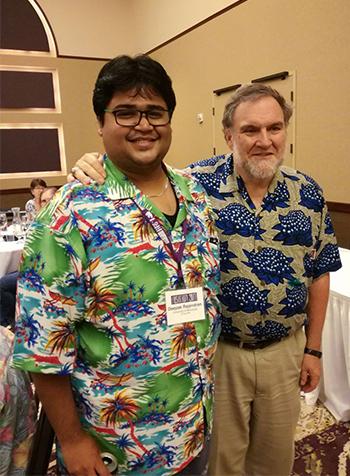By Deepak Haarith, Ph.D. Student

Deepak Haarith with Kansas State University Plant Pathology Professor John Leslie
In the past decade, there have been several developments in mycological taxonomy. The proposal for ‘one fungus, one name’ was finally accepted in 2012 and since then, most fungi have been described only by their teleomorph stage or sexual stage. Exceptions always prove the rule and Fusarium spp. is that exception, for this genus take the name of anamorphs instead of Gibberella, the teleomorph. Not just in the name, this group of fungi also do not fit the rule of having their ITS region help humans barcod and identify them. Fusarium spp. are also unique in the fact that they have B chromosomes, otherwise known as dispensable chromosomes, which are a set of two or more entire chromosomes that are not necessary for sustenance of the fungi, but confer special metabolic and genetic abilities when present.
My internship spanning two weeks from June 19-30 was comprised of two parts. Over the first week, I was working with both Kansas State University Plant Pathology Professor John Leslie from the Fusarium genetics lab, and Director and curator for the Fungal Genomic Stock Center (FGSC) Dr. Kevin McKluskey. This first week, I learned about strain collection and the origins of all the strains of Fusarium spp. and other fungi that the lab has been curating for the Fusarium workshop as well as for other researchers who might want a vial of Fusarium, Neurospora or Aspergillus. At the FGSC, I learned a lot about fungal strain preservation. The current facility has over 5000 strains of fungi curated. I learned about the need for redundancy of techniques in fungal preservation being vital to any culture collection. Some fungi revive better when stored at -80C in glycerol while many others prefer lyophilization or even storing on silica gel at 4C. By storing each strain on all three formats, it is possible to not lose viability. This knowledge will help me curate my mycobiome that I have grown pure from the past three years of sampling soybean cyst nematodes (SCN) while I screen them for nematode antagonism. I had a hands-on experience growing cultures, making spore suspensions, and preserving them to be sent to a customer. In Professor Leslie’s lab, I was given an insider’s view of organizing the Fusarium workshop. I learned how specialized media for inducing spore formations are made and how the strains were collected, preserved, and chosen for the workshop.
Of all the fungi that I have grown out from SCN, about 30-40% of them belong to the genus Fusarium. In my preliminary screenings, fungi that show high parasitism and toxicity on SCN are mostly Fusarium spp. Through this one week internship, growth and maintenance of Fusarium and other related fungi was the main highlight. I discovered some of my lab protocols needed quite a bit of altering. For example, incubating cultures under white and UV light with equal duration of day and night and alternating temperatures, are the best conditions for stable growth and sporulation of fungi. I have only been incubating at one temperature and under white light without any timer for the dark hours. Another important change that I made in my protocols is to use a different media that has been optimized for sporulation of Nectriaceae fungi. All my experiments need spore inoculum suspensions and my present protocol does not yield me enough, most of the time, albeit they were modeled after protocols from published articles.
Taxonomy and in extension, identification of fungi that have good antagonists of SCN is important. Since most effective antagonists are Fusarium, this training will help me identify isolates that are effective and hence report them. Correct identification is crucial to linking metabolic pathways that we might potentially discover for the anti-nematode metabolites secreted by the fungi.
Overall, this internship has been an eye-opener in many ways and will help my current research. The opportunity to interact with several leading scientists from all over the world was priceless. The hosts, Professor Leslie and Dr. McKluskey were kind enough to introduce me to several other KSU faculty who are epidemiologists, mycologists and even the in-house nematologist, Professor Tim Todd. Among the instructors were Professor Yin-won Lee (UMN Ph.D. 1984 – working at Seoul National University) and Professor Rudolph Krska (Austria) who are chemists working on fungal metabolites and are willing to answer questions that might arise in my project. I also interacted with Professor David Geiser (Penn State University), who is a leading fungal phylogeneticist, specializing in the Fusarium genus. This is the third time I have interacted with him and he is already helping me with sourcing materials such as Carnation leaf pieces, which is rare and important. Other notable Fusarium experts include Professor Brett Summerell (Australia), Professor Antonio Logrieco (Italy) and Professor Ludwig Pfenning (Brasil). There were enough socializing events and I had time to meet each one of them, discuss my research, and obtain their perspectives. One of the main issues with my project currently is the volume of samples. I have 6000+ isolates and I need ways to screen and reduce their numbers. I am using UMN supercomputing resources and pipelines but relevant biological information can help us make better choices. Professor Leslie suggested some exclusion criteria for metabolite screening, from that perspective.
I am extremely happy and thankful that our Department of Plant Pathology extended the financial support. This was a very valuable experience at the right time in my career.
